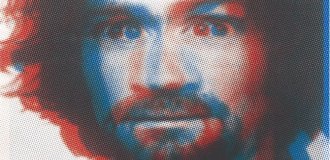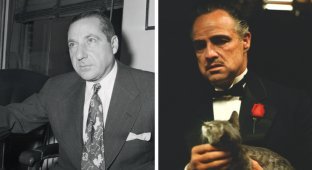10 most famous and influential mafiosi of all time (10 photos)
The Mafia is not only a subject of films and books, but also a real part of history that has left a deep mark on world culture. Many people who became famous due to their connection with organized crime have forever entered the annals of history. We have collected 10 of the most famous Mafiosi of all time, whose names have become synonymous with fear, power, and cunning plans.
Lucky Luciano
Charles "Lucky" Luciano is one of the most famous and influential Mafiosi in US history. Luciano played a key role in organizing the modern Mafia world, creating the "National Mafia Commission", which coordinated the actions of Mafia groups in the United States. His influence on the Mafia structures was enormous, and he is called one of the founders of the American Mafia in its modern form.
Luciano was heavily involved in drug trafficking, extortion, and organized crime, but his ability to connect with power and influential people allowed him to avoid major legal troubles. He was arrested for extortion in 1936, but was released a few years later in exchange for helping fight the fascists in Italy during World War II.
After his return to the United States, Luciano continued to run the business from abroad until he died of a heart attack in 1962. His death was the culmination of an era of Mafia wars and the criminal structures he had helped create. 
Al Capone
Al Capone is a name known to almost everyone interested in the history of crime. This mobster was born in 1899 in Brooklyn, New York, and became one of the most influential criminals of his time. In the 1920s, when Prohibition was introduced in the United States, Capone launched a huge network of illegal production and smuggling of alcohol. This brought him fabulous profits, and he became the head of the Chicago Mafia, controlling not only the sale of alcohol, but also gambling, prostitution and extortion. Capone was famous for his cruelty and his ability to manipulate people, using not only force but also generous bribes.
His career ended in 1931 when he was convicted of tax evasion. The sentence of 11 years in prison was a heavy blow to him, and he spent several years in the famous Alcatraz prison. Capone suffered from a serious illness (pneumonia, then progressive syphilis), and died in 1947 at the age of 48. Despite his early death, Capone became a symbol of the mafia world and inspired many generations to create films and books about the mafia. 
John Gotti
John Gotti, nicknamed "The Trust," was one of the most notorious and powerful mobsters in U.S. history. In the early 1980s, he became the head of the Gambino Mafia family, the most powerful criminal organization in New York City. Gotti became famous for his cunning tactics to avoid justice - he successfully walked free after numerous charges of murder, extortion, and other serious crimes. His ability to manipulate judges and witnesses made him a legend among mobsters.
He was also known for his flamboyant public persona, and loved to show off his power and wealth. However, in 1992, he was arrested and convicted of murder, extortion and other crimes. A witness played a role in this case - his former subordinate, who decided to testify against Gotti. John was sentenced to life imprisonment and died in 2002 from cancer, but until his death he remained one of the most talked about figures in the world of the mafia. 
Carlo Gambino
Carlo Gambino was one of the most powerful mafiosi in the United States, heading the Gambino mafia family, which controlled the criminal world of New York in the 1960s and 70s. Gambino was known for his political manipulation and ability to avoid the attention of law enforcement. Unlike many other mobsters, he was not prone to public reprisals and preferred to operate covertly, which allowed him to maintain power in the Mafia family for many years.
He was behind many criminal operations, including extortion, drug trafficking, illegal gambling and murder, but his personal life remained relatively quiet. Gambino became a symbol of how one could reach the pinnacle of Mafia power through strategic thinking and the ability to hide one’s true intentions. In 1976, Carlo Gambino died of a heart attack at the age of 74. His death marked the end of an era, but his name remains synonymous with Mafia power. 
Meer Lansky
Meyer Lansky was one of the most notorious and influential organizers of the criminal underworld in America, with a vast network of contacts around the world. Born in what is now Belarus, Lansky immigrated to the United States at a young age, where he quickly became a prominent figure in Mafia circles. He was one of Bugsy Siegel's closest associates and played a key role in the development of the Mafia, particularly in his control of gambling and international drug trafficking.
Lansky was also one of the main architects of the creation of the Criminal Association, which united various Mafia families. Despite his reputation as a brutal criminal, Lansky was a master of financial operations, often solving Mafia structures' money problems, and his connections to big business allowed him to achieve impressive success. Lansky remained an important figure until his death in 1983, never being convicted of serious charges, which became the subject of much speculation about his ability to evade justice. 
Vito Genovese
Vito Genovese was the head of one of the most powerful Mafia families in New York, known as the Genovese. Early in his career, he worked under the famous mobster Charles "Lucky" Luciano and gradually became an important figure in the world of organized crime. Genovese was a master at managing Mafia operations, engaged in extortion, gambling, and controlled a wide range of illegal activities in New York.
His name became famous not only in America, but also abroad. Although he was never involved in major public crimes, his tough methods of running his family and his ability to manipulate his rivals helped him to strengthen his position in the Mafia world. In 1957, Genovese was arrested and sentenced to prison, but he managed to avoid serious punishment several years later thanks to his strategic maneuvers and ability to establish connections with the authorities. Genovese died in 1969 at the age of 71, leaving behind a rich legacy in the world of Mafia families. 
Joe Bonanno
Joe Bonanno can be called a long-lived mobster - born in 1905, he died almost a century later, in 2002. This criminal figure was born, like many, in Italy. He headed one of the Five Families - the Bonanno clan. Coming from a poor family, he ended up in the United States twice - the second time he arrived during Prohibition, in 1924. At first, he was engaged in bootlegging, joining the Maranzano gang - he fought on his side in the Castellammarese War. He received income from everywhere: prostitution, loan sharking, bookmaking, illegal sale of alcohol and various other illegal activities.
He ran the family until 1964, after which he suddenly disappeared "from the radar". He showed up 2 years later, claiming that he was kidnapped (however, there is no reliable information about this). During his absence, the family was run by other mafiosi who refused to return power to Joe. However, there were also members of the family loyal to the returning boss, which provoked the "Bonanno War". It ended in 1968 with Joe declaring that he would take a break from business. After that, Joe took up real estate speculation, for which he was sent to prison for 5 years (the first time in his criminal career that he was under investigation). And he died, as mentioned above, at the age of 97, from heart failure. 
Bugsy Siegel
Bugsy Siegel was one of the most famous American mafiosi and is considered one of the creators of Las Vegas as a city of gambling and entertainment. He worked for the Lascana family and was a key player in the development of casinos and gambling in Nevada. In addition, he was also involved in drug trafficking, extortion, and other criminal activities.
Siegel was involved in the mafia world from an early age, but his ambition and desire for a luxurious life allowed him to take an important place in the criminal and business structure. Despite his success, Bugsy Siegel became a victim of mafia showdowns - in 1947, he was shot to death in his home in Los Angeles.
Siegel was killed at the age of 41, and his death was not only a tragedy for his loved ones, but also a symbol of how dangerous and unpredictable the mafia world is. His life and legacy have inspired many writers and directors to create films and books about mafia families. 
Mickey Cohen
Mickey Cohen was one of the most notorious and brutal mobsters of the 1940s, playing a major role in the Los Angeles mafia. Born in New York City in 1913, Cohen became known for his involvement in drug trafficking, gambling, and extortion. However, his main achievement was establishing control over Los Angeles, where he became the main mafia authority.
Cohen worked with the Chicago mafia groups, but at the same time skillfully avoided major conflicts with the local authorities, using bribes and influence. He was also known for his connections with a number of Hollywood stars, which allowed him to strengthen his power in the city. However, his life ended tragically: after several arrests and business losses, Cohen was murdered in 1976. His death became a symbol of the end of the golden era of the mafia families in Los Angeles. 
Frank Nitti
Frank Nitti was one of the most notorious Mafiosi in Chicago and played an important role in the Al Capone organization. Nitti, also known as the "Chicago Czar", was Capone's right-hand man and was responsible for many illegal operations, including extortion, gambling, and drug trafficking. Nitti became known for his penchant for violence and brutality in conducting business, which made him an important player in the Mafia structure.
However, after Capone's arrest in 1931, Nitti became the de facto leader of the Chicago Mafia and began to expand its influence. His reign was full of harsh actions against competitors and the unification of other Mafia groups. But soon Nitti became a victim of persecution by the authorities. In 1943, he was arrested for a number of crimes, and soon committed suicide, abandoning his life in the mafia world. 






















